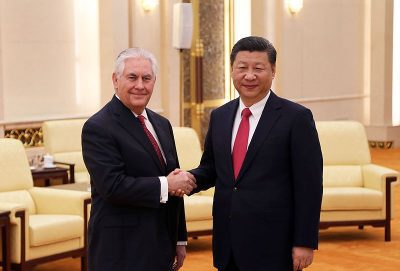America and China in Signs of a Joint Approach to North Korea: THAAD and Double Freeze
Sawako Utsumi and Lee Jay Walker
Modern Tokyo Times

The United States Secretary of State, Rex Tillerson, spoke with calmness and a sense that a breakthrough was possible based on ongoing initiatives behind the scenes with China. Of course, the stumbling block for China is the government of South Korea agreeing to the deployment of THAAD (Terminal High-Altitude Area Defense System). Hence, it appears that the “double freeze” approach spoken by China and the Russian Federation, in relation to easing tensions on the Korean Peninsula, may be gaining headway even if not spoken about openly by America.
Ironically, while Japan and South Korea are especially nervous about the bellicose attitude of North Korea, the opposite can’t be said about China and the Russian Federation. This is based on the deployment of THAAD in South Korea that is irking China and the Russian Federation respectively. Yet, political and military elites in the Russian Federation seek to play a long-term approach to the new reality with South Korea. However, the same can’t be said about China because this nation is openly hostile to the changing dynamics that is widely believed to be aimed at containing the Middle Kingdom of yesteryear.
The New York Times last year reported, “Analysts said the deployment of the so-called Terminal High-Altitude Area Defense system, or Thaad, would reinforce the already high level of mistrust in United States-China relations as the Obama administration nears its end, adding to the raw nerves over disputes in the South China Sea and differences over American business access to the Chinese market.”
Fast forwarding to recent tensions and openly hostile rhetoric by the leaders of America and North Korea, with Japan and South Korea taking different approaches, then maybe China senses a possible combined “double freeze” and THAAD initiative, that embraces the genuine concerns of China. Hence, Tillerson spoke with calmness in China that would indicate that developments are fast-forwarding between the political elites in Beijing and Washington respectively.
Reuters reported from Beijing, “The United States said on Saturday it was directly communicating with North Korea, seeking to start a dialogue with Pyongyang as its advancing nuclear and missile programs stoke fears of an armed confrontation.”
Tillerson notified the media that America and North Korea were not in complete darkness towards each other. On the contrary, two or three channels were open between both nations and Washington was eager to know what North Korea wants on the table. Of course, Tillerson kept the details of the channels close to his chest but stressing this in China would tend to lead to an important role being played by political elites in Beijing.
Tillerson continued to stress that China was now moving in-line with America’s posture – albeit, from different geopolitical angles. This, according to Tillerson, is based on China understanding the advancing nuclear and missile development of North Korea is getting out of control. Yet, neither China nor the Russian Federation feels threatened by North Korea – only the consequences of a major war that would lead to millions of refugees and a possible negative change on the Korean Peninsula in the aftermath. In other words, it seems likely that China is expressing its complete dismay by the deployment of THAAD and other issues related to the South China Sea. Hence, it appears likely that America is offering China something in order to work closer together on the Korean Peninsula.
Modern Tokyo Times reported about the “double freeze” by stating, “This double freeze relates to a plan formulated by China and the Russian Federation, whereby related players would abide by conditions that would reduce tensions. In other words, political and military elites in Pyongyang would abide by putting a freeze on its missile tests – while the governments of America and South Korea would relent on major military exercises by imposing a genuine moratorium.”
Tillerson said, “I think they also have a sense that we’re beginning to run out of time and that we really have to change the dynamic.”
Interestingly, given recent bellicose statements by President Donald Trump of America, Tillerson said, “Look, our objective is denuclearization (of North Korea)… Our objective is not to get rid of you. Our objective is not to collapse your regime.”
Of course, much needs to be done to reduce tensions on the Korean Peninsula. Similarly, America and South Korea need to acknowledge the genuine concerns of China and the Russian Federation in relation to THAAD. This equally applies to America’s containment policies aimed at both China and the Russian Federation by America utilizing Japan and South Korea respectively in Northeast Asia. Therefore, with Tillerson speaking with calmness in China – and understanding the importance of this nation in relation to North Korea – then it could well be that a “double freeze” and THAAD debate is equally on the table based on China’s gradual tightening of its policy towards North Korea.
http://moderntokyotimes.com/?p=7602
https://www.nytimes.com/2016/07/09/world/asia/south-korea-us-thaad-china.html

Modern Tokyo News is part of the Modern Tokyo Times group
DONATIONS to SUPPORT MODERN TOKYO TIMES – please pay PayPal and DONATE to sawakoart@gmail.com
http://moderntokyotimes.com Modern Tokyo Times – International News and Japan News
http://sawakoart.com – Sawako Utsumi personal website and Modern Tokyo Times artist
https://moderntokyonews.com Modern Tokyo News – Tokyo News and International News
http://global-security-news.com Global Security News – Geopolitics and Terrorism
PLEASE JOIN ON TWITTER
https://twitter.com/MTT_News Modern Tokyo Times
PLEASE JOIN ON FACEBOOK